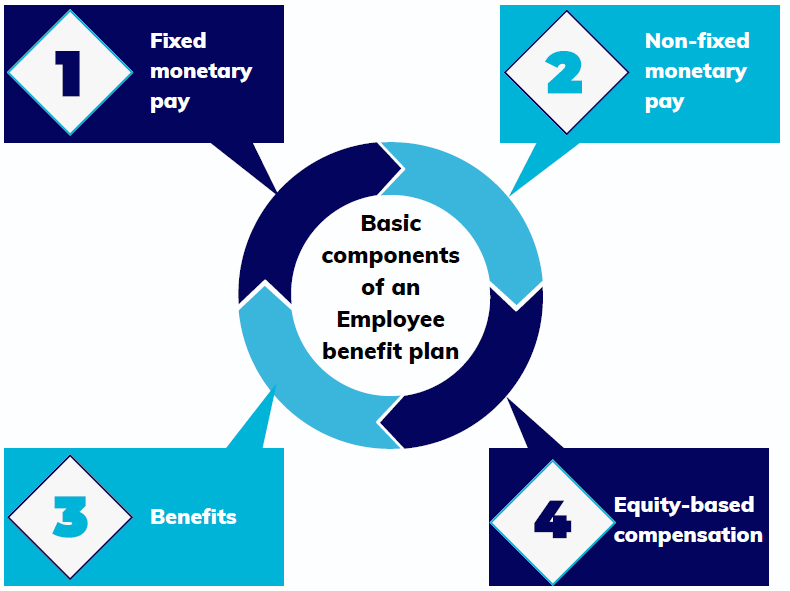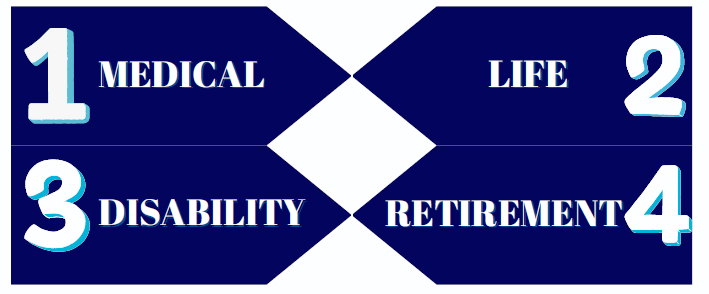What is the Employee benefit plan?
The employee benefit plan is the benefits plan termed as a premium benefits or a perquisites. Employee Benefit plans are the non-fiscal benefits that are offered by the employer to the employees apart from their salaries. At some places, the employee benefit plans can be mandated by laws at or can be provided voluntarily by the employers.
The employer feels assured that employee benefits will make their employees feel motivated and satisfied and they will serve the organization in a better way. The employee benefit plans include
- Paid vacations,
- Health insurance and Life insurance,
- Retirement benefits,
- Gratuity, etc.
Employee benefit plans work as an effective strategy to retain talented employees within the organization.
Key features of Employee Benefit Plan
- Employee benefits are not based on the specific performance of the employee. These benefits are given to employees for boosting their interest in the work and make their work even more productive.
- Employee benefits are not specified for any particular group or team. Employee benefit plans do not take the element of the performance of employees but are meant for making the employees feel valued.
Advantages of employee benefit plan
The company offer employee benefit plan to their employees to keep them motivated and to retain their talented employees. Companies often provide benefits to employees as a need. The advantages of an employee benefit plan are-
-
To retain the talent of the organization
Employee benefits play a very important role in retaining the talent of your organization. By giving employee benefits to the employees, makes the employees feel that the company care about their needs and they are valuable for them. This helps in retaining the talent of the organization for a longer period.
-
Increases work efficiency and productivity
The main reason behind providing the employee benefit plan is to increase the work efficiency of their employee, as most of the employees are worried because of their financial stress. As a result, they are not able to focus on their work completely which affects the productivity of the organization. So, by offering employee benefits to its employees, the company helps them to have less financial stress so that they can focus on their work and can enhance the organization productivity.
-
Increases the presence at the workplace
The advantage of employee benefit is that it helps in increasing the presence of employees at the workplace. Once the employees are in good financial health, they will not miss out on the work and would be present at the workplace. This will also increase the productivity of the organization.
Employee benefit helps in fostering the loyalty from the employees. With the package of employee benefits, the probability of the employees searching for new chances outside will reduce. The employee benefits improve the scope of your employees being loyal towards you.
Employee benefits help in better recruitment. It helps in attracting more candidates towards the organization. Employee benefits are very important to build the employee's trust. The employee will prefer joining an organization which provides a good salary and also good employee benefits to their employee.
-
Promote employee health and wellness
Employee benefit plans include health and life insurance, preventive doctor care, free health checkup which helps the employees in the maintenance of good health conditions and promoting their wellness. These benefits make the employees more satisfied with your organization.
Employee benefits offerings are used as a strategy to defeat the competitors in the market. Proper strategies should be made by adding some additional features in the employee benefits plan that are not being offered by the competitor.
Basic components of an Employee benefit plan
The basic components of the Employee benefit plan are divided into four basic categories:

A fixed monetary is also termed as Guaranteed pay which is a reward paid by an employer to an employee. The most common form of Fixed monetary pay is base salary. Fixed monetary pay also includes allowances like housing and transport allowance, Differentials allowance, and premium allowance.
A non-fixed monetary is also termed as Variable pay which is a reward paid by an employer to an employee that is conditional on circumspection, performance, or results achieved. The common form of Non-fixed monetary pay is Bonuses and incentives.
Benefits are given by the employer to supplement employees compensation, i.e. medical insurance, company car, etc.
-
Equity-based compensation
Equity-based compensation is non-cash pay that denotes ownership in the firm. Equity-based compensation allows the employees of the firm to share in the profits and can encourage retention.
How to create an effective employee benefit plan
Effective employee benefits are an important and high-priced attempt for employers. Employers are required to provide mandatory benefits that are voluntary in nature and determined by the employer. Benefits programs differ from organization to organization, but it must include medical insurance, life, and disability insurance, retirement income plan benefits, paid-time-off benefit plans, and educational support programs.
Selecting an effective employee benefits plan is the analytic component in the total compensation costs. Before, creating an effective employee benefits plan, the employers should have a well-computed employee benefits plan that meets both employee needs and employer objectives.
-
Recognizing the Organization's aim and Budget
The first step is recognizing the organization's aim and budget before designing an employee benefits program. This helps in providing overall guidance in establishing the well-designed employee benefits program. The program provides an overview of the organization's aim of offering benefits that reflect both the employer and employee needs. The organization's business strategy helps in conducting the development of the benefits plan. Generally, employers choose a general benefits plan, whereas other employers include the objectives in their total compensation principles. The Employee benefits plan is not static and should be evaluated and revised to reflect the current employer strategy and employee needs.
-
A proper assessment program
A proper assessment program should be conducted to determine the best employee benefits is based on the needs and wants of the employees. The assessment program includes an employer's thought of employee benefits needs, competitor's benefits practices, and tax laws and regulations. In an assessment program, it is important to take a market research approach to employee benefits planning.
The Organization should examine the existing employees statistics in discovering the needs of various categories of employees. Employers can analyze the needs of the employee and compare them with any existing benefits and against existing benefits to categorize which benefits will be most helpful in achieving the objectives of the benefits program.
-
Implementing an Employee Benefits Plan
Once the assessment program is done by the employer, the organization needs to implement an employee benefits plan design. The employer formulates an employee benefits plan and will determine the cost of providing the categorized benefits and assessing it against the benefits budget.
Implementing an employee benefits plan is a complex process and takes into consideration various factors: Various factors that are taken into consideration are-
a) Can alterations be made to the current plan design to induce cost savings?
b) Can benefits that are underused or not valued by employees be eliminated?
c) Evaluating the administrative costs for the benefits
d) Evaluating that is the cost-cutting features
e) How much the employee's cost will have to contribute?
-
Communicating the employee benefit plan to the employees
Communication is an important element of an employee benefit plan. Employers need to make the employee understand the benefits of an employee benefit plan. The employer is compelled to communicate with the employees and comply with laws regarding the disclosure of various benefits plans. Communication with the employees creates awareness and acknowledgement of the new or existing benefits and improving employee financial security.
Conclusively, periodical review of the employee benefits plan. The benefits program must be reviewed regularly to determine that the employee benefit plan is meeting the organization's aim and employees' needs. Employers may also consider external factors to evaluate the effectiveness of the benefits plan.
Types of employee benefits plan
The 4 major employee benefits that every company should offer to the employee are-

Medical Benefits include
- Medical Insurance
- Dental Insurance
- Vision Insurance
- Health saving account
- Health Reimbursement Account
- Cancer Insurance
- Critical Health Insurance
- Hospital Insurance.
Life Benefits include
- Life Insurance
- Accidental Death Insurance
Disability Benefits include
- Disability Insurance
- Accident Insurance
Retirement Benefits include
- Retirement plan
- Pension fund
- Gratuity
How TAP GLOBAL helps in providing services related to Employee benefit plans?
TAP GLOBAL, as a consulting firm provides customized communication and web portal services to its clients so that employees of that particular organization can learn about the benefits options available to them.
As a consultant, TAP GLOBAL offers ongoing assistance to its client with their human resources needs. TAP GLOBAL helps in renewing the plans as per the organization's objective and advises its client on ways to reduce the cost of employee benefits packages.
How to reach TAP GLOBAL?

Fill The Form

Get a Callback

Submit Document

Track Progress

Get Deliverables